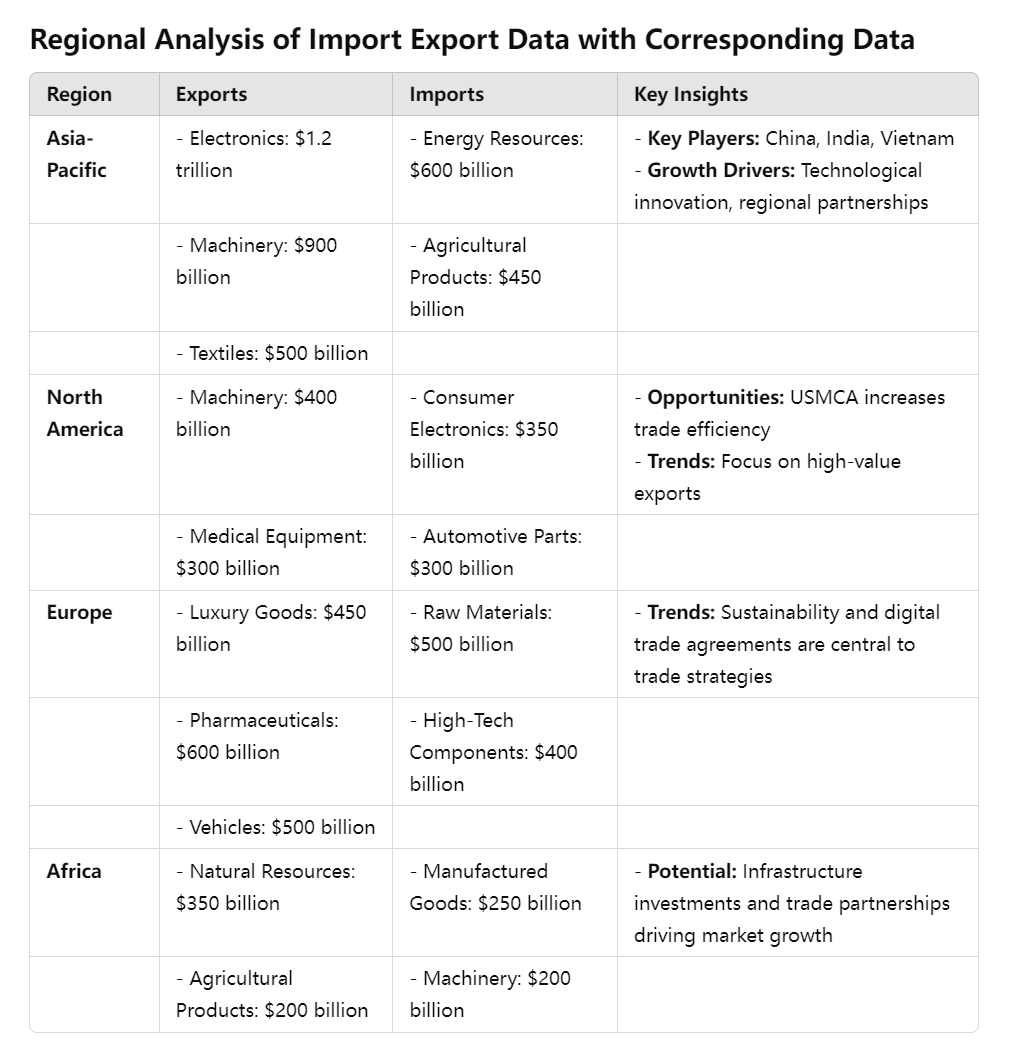2025 Global Import Export Data: Trends Shaping the Future of Trade
Introduction
Global trade serves as the backbone of the international economy, facilitating the movement of goods, services, and capital across borders. In 2025, import and export data reveals transformative trends that are reshaping the global trade landscape. From technological advancements to shifting geopolitical dynamics, businesses must analyze these developments to remain competitive. This article dives into the latest trends in2025 global import export data, offering actionable insights for businesses.
1. Key Trends in 2025 Global Trade
a) The Rise of Emerging Markets
Emerging economies, particularly in Asia, Africa, and South America, are experiencing accelerated growth. Key drivers include:
- Increased investment in infrastructure.
- Trade agreements fostering regional integration.
- Growing consumer demand for manufactured goods and raw materials.
Example:Countries like Vietnam and Kenya are becoming major players in global supply chains, driven by competitive labor costs and government incentives.
b) Digitalization of Trade Data
Advancements in technology are revolutionizing how trade data is collected, analyzed, and utilized. Features include:
- Real-time tracking of shipments.
- Predictive analytics for supply chain optimization.
- Blockchain integration for secure and transparent transactions.
Impact:Businesses using data platforms like SaleAIgain an edge in identifying market trends and improving operational efficiency.
c) Sustainability in Trade
The demand for environmentally friendly goods and sustainable supply chains is growing:
- Governments are enforcing stricter environmental regulations.
- Consumers are choosing products with lower carbon footprints.
Example:The European Union's Carbon Border Adjustment Mechanism (CBAM) is influencing global trade patterns, prompting exporters to adopt greener practices.
2. Regional Analysis of Import Export Data
a) Asia-Pacific
- Exports:Electronics, machinery, and textiles remain dominant.
- Imports:Increased demand for energy resources and agricultural products.
- Key Players:China, India, and Vietnam are driving growth through technological innovation and regional partnerships.
b) North America
- Exports:High-value goods like machinery and medical equipment.
- Imports:Consumer electronics and automotive parts dominate imports.
- Opportunities:Trade agreements like USMCA bolster regional trade efficiency.
c) Europe
- Exports:Luxury goods, pharmaceuticals, and vehicles.
- Imports:Raw materials and high-tech components.
- Trends:Digital trade agreements and sustainability are at the forefront of Europe’s trade strategy.
d) Africa
- Exports:Natural resources and agricultural products.
- Imports:Manufactured goods and machinery.
- Potential:Infrastructure investments and trade partnerships are boosting Africa’s role in global markets.

3. Challenges Impacting Global Trade in 2025
Despite growth, global trade faces hurdles:
a) Geopolitical Tensions
Trade wars and sanctions between major economies, such as the U.S. and China, create uncertainty.
b) Supply Chain Disruptions
Pandemics, natural disasters, and port congestions continue to disrupt supply chains.
c) Rising Protectionism
Governments imposing tariffs and trade barriers impact global trade flows.
d) Data Accessibility
While trade data is critical, businesses without access to comprehensive platforms like SaleAI struggle to gain insights.
4. How Businesses Can Leverage 2025 Trade Data
To thrive in a competitive global market, businesses should:
a) Analyze Market Trends
Utilize platforms likeSaleAIto:
- Identify emerging markets.
- Monitor competitor activities.
- Explore new product opportunities.
b) Optimize Supply Chains
Trade data helps:
- Reduce shipping costs by analyzing import/export routes.
- Ensure timely deliveries through predictive analytics.
c) Comply with Regulations
Stay updated on:
- Country-specific tariffs and trade agreements.
- Environmental regulations impacting product categories.
d) Expand Globally
Use data insights to:
- Diversify export destinations.
- Build relationships with reliable suppliers and distributors.
Conclusion
The2025 global import export datalandscape offers businesses both opportunities and challenges. Companies leveraging advanced trade data analytics can uncover untapped markets, streamline operations, and gain a competitive advantage.
Platforms likeSaleAIempower businesses to analyze global trade data, track shipments, and make informed decisions in an ever-changing economic environment. By staying data-driven, businesses can unlock sustainable growth and success.
"Unlock the power of 2025 trade data with SaleAI. Start exploring insights today!"



